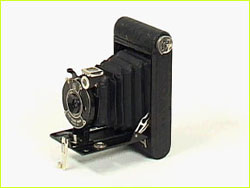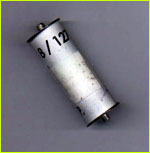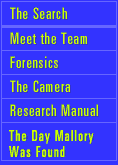
|
 |
 |
See an object QTVR of the camera (700k) Introduced in 1912, the original Kodak "Vest Pocket" Camera represented "breakthrough technology" for its day. The pocket-sized folding camera looked almost exactly like the larger folding Kodaks but used a new small film size. The little rolls of film yielded eight 1 5/8" X 2 1/2" exposures each—large enough to make contact prints but small enough to keep the camera palm-sized. The so-called "miniature" camera first retailed at $6.00—far less than the larger folding models—and became popular with soldiers during World War One. The "Vest Pocket Model B," which Mallory used on Everest, was introduced in 1924, and included several new design features. One of the most significant was the "autographic" window on the camera back. By sliding a small door open, the photographer was able to inscribe some information about the picture through the backing paper, directly onto the film—a distant ancestor to today's "day / date" modes in some electronic cameras. Improvements were also made in roll-loading by making the entire front of the camera removable. Developing Mallory & Irvine's Film by Steve Garfinkel and Bob Strickland No century has been so thoroughly documented as the one we are about to exit. By 1924 the small camera, often a folding model, was a fixture in homes worldwide, finding most of its function on vacations and picnics, beaches, and similar idyllic sunny days. The little Vest Pocket Kodak Model B that found itself slowly ascending the treacherous slopes of Mt. Everest had a somewhat more important task. Loaded with "NC," or Non-Curling black-and-white film, it was a compact recorder of the destiny of the ill-fated expedition. Despite the proliferation of the word "digital" to describe everything from television to toothpaste, black-and-white photography, in its elegant simplicity, has required few new innovations to create images.
According to one of us (Bob Strickland, a Kodak Photographic Expert for over 30 years), the recommendations for the priceless film include keeping it frozen until just before development, thus preserving its physical state. Secondly, a small snipping of the roll's end should be taken in total darkness and processed to determine the exposure and type of images recorded on the film. Processing solutions should likely be kept at temperatures of no more than 70 degrees, with a reduced-activity developer to minimize image "grain." As a result, longer developing times must be used. While these are strictly recommendations only, preliminary experiments on the small end cuttings will reveal the effects of the developing tests. Although the film was, by nature, blue-light-sensitive only, the use of a safelight is not recommended, given the danger of adding fog to the film's emulsion.
Back to The Search Steve Garfinkel and Bob Strickland are based at Kodak in New York, New York. Photos: (1) Peace River Studios; (2) NOVA/WGBH. Lost on Everest | High Exposure | Climb | History & Culture | Earth, Wind, & Ice E-mail | Previous Expeditions | Resources | Site Map | Everest Home Editor's Picks | Previous Sites | Join Us/E-mail | TV/Web Schedule About NOVA | Teachers | Site Map | Shop | Jobs | Search | To print PBS Online | NOVA Online | WGBH © | Updated November 2000 |

 A roll of film for use in the Kodak Vest Pocket
camera.
A roll of film for use in the Kodak Vest Pocket
camera.
